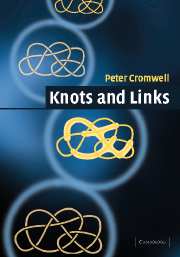Book contents
- Frontmatter
- Contents
- Preface
- Notation
- 1 Introduction
- 2 A Topologist's Toolkit
- 3 Link Diagrams
- 4 Constructions and Decompositions of Links
- 5 Spanning Surfaces and Genus
- 6 Matrix Invariants
- 7 The Alexander–Conway Polynomial
- 8 Rational Tangles
- 9 More Polynomials
- 10 Closed Braids and Arc Presentations
- Appendix A Knot Diagrams
- Appendix B Numerical Invariants
- Appendix C Properties
- Appendix D Polynomials
- Appendix E Polygon Coordinates
- Appendix F Family Properties
- Bibliography
- Index
2 - A Topologist's Toolkit
Published online by Cambridge University Press: 05 June 2012
- Frontmatter
- Contents
- Preface
- Notation
- 1 Introduction
- 2 A Topologist's Toolkit
- 3 Link Diagrams
- 4 Constructions and Decompositions of Links
- 5 Spanning Surfaces and Genus
- 6 Matrix Invariants
- 7 The Alexander–Conway Polynomial
- 8 Rational Tangles
- 9 More Polynomials
- 10 Closed Braids and Arc Presentations
- Appendix A Knot Diagrams
- Appendix B Numerical Invariants
- Appendix C Properties
- Appendix D Polynomials
- Appendix E Polygon Coordinates
- Appendix F Family Properties
- Bibliography
- Index
Summary
Most mathematics texts start from a specified base of mathematical knowledge, add some new ideas, and build on what has been previously studied to develop a familiar topic to a deeper level, or in a new direction. All the stages in the development of the theory are carefully proved and explained with nothing being assumed or hidden. If this pattern were strictly adhered to, knot theory would not be studied at undergraduate level.
To make the study of knot theory mathematically rigorous requires a fair amount of topological sophistication. We have seen that, if we are not careful, our definitions can lead to unexpected results. Trying to understand and exclude wild behaviour was one of the central questions for topologists in the middle of the twentieth century. Many strange spaces and embeddings were created to provide counterexamples to various conjectures. Eventually this work resulted in a firm foundation for geometric topology.
The fact that these foundations have not been studied should not inhibit progress. We shall proceed as working topologists do and just quote the useful results, safe in the knowledge that they have been established elsewhere. Just because we do not understand how a house is constructed that does not mean we cannot live in it.
The results we need are a set of ‘tameness’ conditions: they provide the reassurance that the topological world behaves as we expect it to.
- Type
- Chapter
- Information
- Knots and Links , pp. 31 - 50Publisher: Cambridge University PressPrint publication year: 2004



